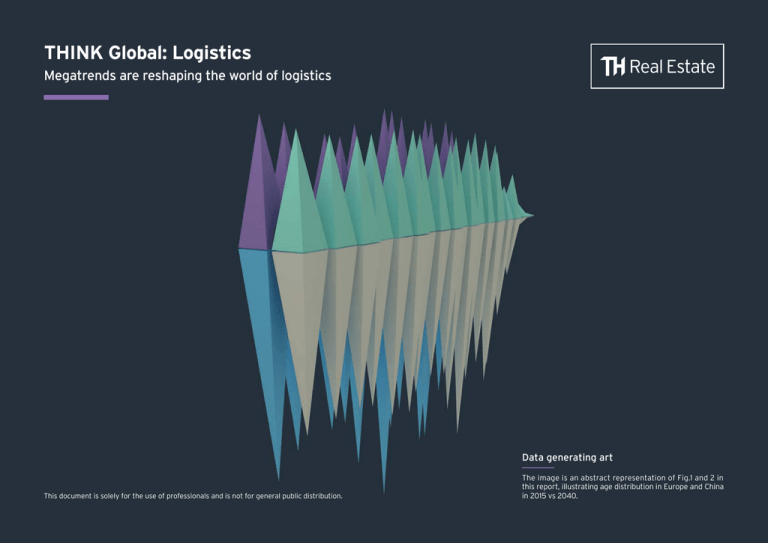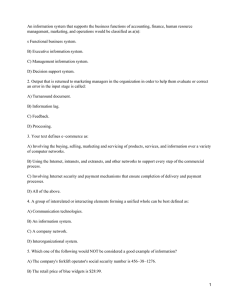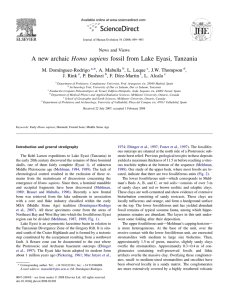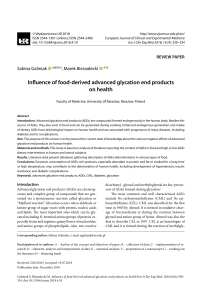THINK Global: Logistics
Anuncio

THINK Global: Logistics Megatrends are reshaping the world of logistics Data generating art This document is solely for the use of professionals and is not for general public distribution. The image is an abstract representation of Fig.1 and 2 in this report, illustrating age distribution in Europe and China in 2015 vs 2040. Introduction Megatrends will have a profound impact on logistics real estate around the world. New technology and increased connectivity will lead to growth in online shopping, which will drive demand for logistics space. The shift of economic power to the East will give rise to a new middle class fuelling retail spending and logistics in new locations. Population growth will support economic advances in many developing countries, whereas an ageing population will reshape consumer patterns in developed countries. Due to urbanisation and the global trend to live in cities, the production and consumption of goods will become geographically more concentrated, making distribution more challenging. This report attempts to explore these repercussions in more detail. Global megatrends spawn a myriad of demographic, economic, social and technological changes, some of which will have significant implications for the logistics sector. Logistics real estate has already evolved to cater for complex services that a simple shed can no longer provide. Megatrends will be accompanied by increased supply chain complexity and will require the sector to constantly adapt. Stefan Wundrak Head of European Research 2 THINK Global: Logistics Population growth and ageing The global population surpassed seven billion in 2012, and the UN forecasts that the eight billion mark will be reached before 2025, followed by nine billion before 2040, when growth is expected to slow considerably. According to Oxford Economics, 35% of the increase in population will be in lower income countries, and 65% in the poorest parts of the world, while developed countries will not grow at all. More people means more physical goods production and consumption, inevitably requiring additional logistics capacity. However, the question over how many middle class households with the ability to spend on consumer goods will arise from that overall enormous growth in population is a more relevant yardstick and will be analysed in a later chapter. Ageing population is not just a rich world phenomenon, but it will make the most significant impact in the near future in developed countries. Changing incomes and consumption preferences by age suggest that an older population will shop differently. The US Bureau of Labour’s statistics show that US consumer spending peaks around the age of 45-54 and total spending on clothing even earlier at the age of 25-34. As the share of older people is rising, logistics will have to follow their changes in consumption patterns. With an older population consuming more services instead of going shopping, demand for logistics space in developed countries could potentially be stifled. Fig.1: Age distribution in Europe 2015 vs 2040 Fig.2: Age distribution in China 2015 vs 2040 2015 estimates 2040 medium variant Ages 100+ 2015 estimates Ages 100+ 2040 medium variant Ages 100+ Ages 100+ Ages 95-99 Ages 95-99 Ages 95-99 Ages 95-99 Ages 90-94 Ages 90-94 Ages 90-94 Ages 90-94 Ages 85-89 Ages 85-89 Ages 85-89 Ages 85-89 Ages 80-84 Ages 80-84 Ages 80-84 Ages 80-84 Ages 75-79 Ages 75-79 Ages 75-79 Ages 75-79 Ages 70-74 Ages 70-74 Ages 70-74 Ages 70-74 Ages 65-69 Ages 65-69 Ages 65-69 Ages 65-69 Ages 60-64 Ages 60-64 Ages 60-64 Ages 60-64 Ages 55-59 Ages 55-59 Ages 55-59 Ages 55-59 Ages 50-54 Ages 50-54 Ages 50-54 Ages 50-54 Ages 45-49 Ages 45-49 Ages 45-49 Ages 45-49 Ages 40-44 Ages 40-44 Ages 40-44 Ages 40-44 Ages 35-39 Ages 35-39 Ages 35-39 Ages 35-39 Ages 30-34 Ages 30-34 Ages 30-34 Ages 30-34 Ages 25-29 Ages 25-29 Ages 25-29 Ages 25-29 Ages 20-24 Ages 20-24 Ages 20-24 Ages 20-24 Ages 15-19 Ages 15-19 Ages 15-19 Ages 15-19 Ages 10-14 Ages 10-14 Ages 10-14 Ages 10-14 Ages 5-9 Ages 5-9 Ages 5-9 Ages 5-9 Ages 0-4 Ages 0-4 Ages 0-4 Ages 0-4 126,000 140,000 98,000 112,000 84,000 56,000 70,000 28,000 42,000 14,000 0 14000280004200056000700008400098000 112000 126000 140000 0 126,000 140,000 98,000 112,000 84,000 56,000 Source: United Nations, 2015 70,000 28,000 42,000 14,000 0 14000280004200056000700008400098000 112000 126000 140000 0 60,000 50,000 40,000 30,000 20,000 10000 20000 30000 40000 50000 60000 10,000 THINK Global: Logistics 0 0 3 60,000 Source: United Nations, 2015 50,000 40,000 30,000 20,000 10000 20000 30000 40000 50000 60000 10,000 0 0 Shift of economic power to the East While the economic rise of the East means fast-rising production and increased consumption of goods in that part of the world, it eventually encourages manufacturing to return to developed markets. The flip side of Asia becoming more affluent is the gradual erosion of cost advantage. Anecdotal evidence suggests that off-shoring to Asia has slowed, with some manufacturing activities even returning to developed markets. For logistics in developed markets, it could mean that the growth of the flow of goods arriving via seaports and airports from overseas may slow. On the other hand, regional distribution in today’s manufacturing regions, in developing countries, is set to require more capacity as local production also gets consumed within the region. This shift is evident in improving service capabilities. The World Bank Logistics Index, measuring the efficiency of logistics services, shows progress across developing Asia over the past decade, particularly in China, Vietnam and the Philippines. Fig.3: World Bank Logistics Performance Index Singapore 3.91 Hong Kong 3.83 Taiwan 3.72 Korea 3.67 Malaysia 3.59 China 3.53 Thailand 3.43 Vietnam 3.15 India 4 THINK Global: Logistics 3.08 Indonesia 3.08 Philippines 3.00 Pakistan 2.83 Cambodia 2.74 Sri Lanka 2.70 Bangladesh 2.56 Source: World Bank, 2015 Shanghai harbour 4.00 Japan The rise of the global middle class The increase of the consumer class, which is defined as households with an income of at least $35,000 (at purchasing power parity), is the key variable to estimate growth in demand for logistics space. In order to analyse the impact on logistics, this threshold is useful as it marks the income level where households can afford Western consumer goods (TV, car, smartphone etc) in meaningful quantities, and trigger logistics space demand in retail and further down the value chain in manufacturing. The seven largest emerging markets (E7: Russia, China, Indonesia, India, Brazil, Turkey and Mexico) will add 277 million consumer class households by 2030 (+172%), with the G7 of developed large economies adding only 34 million (+16%). By 2030, there will be 252 million consumer class households in the G7 countries, with almost double (c.437 million) as many in the E7 countries (Source: OEF). This rapid growth of the consumer class in developing countries will have positive effects on the logistics markets in the developed world as, for example, luxury items or high-end machinery is exported to developing countries. But the bulk of new space demand will be created in the countries where these new consumers live and most of their consumer products are assembled (hence the new wealth). Fig.4: Consumer class - 2015 distribution of middle class households Fig.5: Consumer class - 2030 distribution of middle class households Emerging Seven (E7) Group of Seven (G7) Emerging Seven (E7) Group of Seven (G7) 160 million households 218 million households 437 million households 252 million households Note: Relates to number of households. Source: Oxford Economics, 2015, in PPP 2012 constant prices 5 Inter-regional trade in Asia has expanded rapidly. For example, China’s trade with its peers in the Asia-Pacific region has increased by more than 200% in nominal terms over the past 10 years (Source: Government of China). Some of the fastest growth in trade has been achieved between China and other developing countries. It implies fast-growing demand for logistics in the Asian region will increasingly be geared to serve consumers within Asia rather than shipments to Europe and North America. THINK Global: Logistics Note: Relates to number of households. Source: Oxford Economics, 2015, in PPP 2012 constant prices Urbanisation Not only is the global population growing rapidly, it is also increasingly concentrated in cities. In 2015, 54% of the worldwide population lived in an urban area, which is expected to rise to over 66% by mid-century. Even in the highly-urbanised developed world, rural areas will continue to lose population to larger cities. Tokyo, for example, is estimated to be home to 38 million people. Asia accounts for over half of the world’s 29 megacities in 2015. Nearly 9% of the world’s population will be living in just 41 megacities (those with more than 10 million inhabitants) by 2030. But it is in the developing world, particularly in Africa, that some of the most rapid urbanisation is taking place. Kinshasa, the capital of the Democratic Republic of Congo, will see its population increase a hundred-fold from 200,000 in 1950 to a projected 20 million by 2030; Lagos, the most populous city in Nigeria, will have over 24 million residents by that time. due to sustainability and liveability consideration, increased density will be unavoidable. Logistics real estate has a large footprint and is a relative low-value activity (per sq m). That means the sector will find it increasingly hard to be accommodated in a highly urbanised environment. This pressure on logistics is exacerbated by the low popularity of logistics with residents and city planners. Logistics is associated with 24-hour activity causing traffic and noise, while adding a rather small number of relatively low-paid jobs to the local area. Due to the limited economic value per sq m, logistics tends to add little to the local tax base. With existing cities having to accommodate additional population and many cities being geographically constrained, Demand for logistics will continue to increase, but the supply of suitable land in cities is more likely to decrease. While this is an attractive scenario for real estate investors, as it implies rental value increases, it puts logistics users under pressure to find alternative solutions, limiting the land use of the sector and reducing the local environmental impact in terms of Speicherstadt Hamburg: Late 19th century vertical warehouse Logistics integrated in mixed-use projects 6 THINK Global: Logistics vehicle pollution and noise. This will be a challenge as, at the same time, an increase in online shopping will require more urban logistics premises to fulfil late cut-off deliveries. Multistorey warehousing, as it was common in busy harbours such as Hamburg and London in the late 19th century, may make a comeback. They have appeared in extremely dense cities such as Hong Kong and Tokyo, and even in Europe, in the form of mezzanine levels built into warehouses used for e-commerce. Including logistics in urban mixed-use projects could also become part of a solution. Mixing residential and commercial activities with a logistics inclusion, within districts or even within buildings, would also mark a renaissance of the 19th century European city model, where different types of building uses were less segregated than in modern cities today. Multi-storey warehouse in Hong Kong Technology and global interconnectedness The advance of (information) technology, and the resulting global interconnectedness, impacts logistics real estate on different levels. The most obvious factor is the rise of e-commerce transforming the supply chain in the retail sector. It has been widely documented that e-commerce is creating occupier demand for large fulfilment centres, often with mezzanine space and increasingly automated. E-commerce logistics in urban areas additionally requires smaller, more local, distribution centres and parcel hubs. The trend towards ever shorter delivery times and the need to handle returns efficiently, means that e-commerce increases the overall footprint of logistics space servicing retail. developed to developing/emerging economies, particularly China. Cost pressure will ensure that manufacturing will continue to move on to new frontier markets, and technology is set to support that spread. However, these new manufacturing countries tend to be far up the risk curve and attract institutional real estate investments at a much later stage of economic development. Global interconnectedness spawns a myriad of changes in manufacturing, but only a few could have significant real estate implications. Interconnectedness, in terms of physical transport and the flow of information, has led to a shift in capacity from For logistics in developed markets, it makes little difference from where goods are arriving. However, due to technological advances, manufacturing becomes much more than just production and includes a wide range of service activities. As a result, manufacturing generates demand for a far wider range of real estate than just factories. This is clearly the case, for example, with R&D facilities, which are often co-located with production and logistics premises which support manufacturing. This is especially common where factories are supplied just in 3D printer Logistics relies on technology 7 THINK Global: Logistics time, as the factory creates demand for logistics facilities in close proximity to handle the delivery of parts to the production process. The line between manufacturing and logistics properties becomes blurred, and logistics buildings will gradually house more technology and also more people working on site. A case in point is 3D printing, which could not only encourage reshoring to developed countries for products consumed there, but also change the nature of factories in certain industries. Instead of large bespoke factories, it may create demand for more small and medium-sized buildings, possibly looking more like standard logistics premises. Companies would be more likely to lease than own standard buildings of that type. Resource shortage and sustainability Most initiatives targeting the sustainability of commercial real estate are applicable for logistics premises as well. They range from using sustainable building materials to heating, water and waste management strategies. Principally, improvements are achieved via more efficient management and the application of new technology, which means inefficient basic sheds for storage will play an ever smaller role for occupiers, and therefore should also be phased out of investors’ portfolios. What separates logistics properties from other real estate is the extensive land use, compared to the value of the economic activity, and the knock-on effects that location choices have on the sustainability of the mode of transport of the goods going through the building. The latter can mean that, for example, locations also catering to rail transportation are favourable to exclusively relying on lorries or even air freight. Especially for long distances, rail is gaining popularity again. The over 10,000 km long freight rail link from China (Chongqing, Chengdu) to Europe (Duisburg, Malaszewicze) takes about two weeks and is increasingly used to transport industrial products. It follows rail infrastructure investments in China, but will require further investment in various transit countries before it can develop into more than a niche in the trade link between continental Asia and Europe. Trans-Eurasia rail logistics 8 THINK Global: Logistics Logistics developers and operators have been under pressure to minimise the sector’s large footprint of land. Modern logistics buildings can easily cover 50,000 sq m and require in total around 100,000 sq m of land once axillary roads and loading areas are taken into account. Due to noise and lorry exhaust pollution, logistics tends to get pushed into fringe areas of population agglomerations. Building on green field sites is usually the cheapest option, also considering that very large plots are required. Governments and local authorities favour brownfield sites, reducing the environmental impact. In particular, in very densely populated countries such as Singapore, the Netherlands or Germany, governments have put policies in place to minimise the development of logistics on greenfield sites. The German government has targeted a reduction in overall use of greenfield land from about 900,000 sq m per day to 300,000 sq m per day by 2030. While former industrial brownfields are often in suitable locations for logistics, past contamination can make it significantly more expensive and risky for developers to build on them. These plots may also be too small to accommodate larger units. With population growth and rapid urbanisation, the scarcity of development land will become ever more acute across less developed countries as well. Greenfield logistics development Conclusion This report only scratches the surface of megatrends and their impact on logistics real estate. Smart investors need to follow them closely to anticipate the transformation that different cities, countries and segments of the markets will go through as a result of these megatrends playing out. Fig.6: Urban populations - Size of urban population 1980 Fig.7: Urban populations - Size of urban population 2040 Source: Oxford Economics, TH Real Estate, 2015 Source: Oxford Economics, TH Real Estate, 2015 9 THINK Global: Logistics Contact us Stefan Wundrak Head of European Research T: +442037278226 E: [email protected] Alice Breheny Global Co-Head of Research T: +442037278122 E: [email protected] [email protected] threalestate.com @THRealEstate14 This document is intended solely for the use of professionals and is not for general public distribution. Any assumptions made or opinions expressed are as of the dates specified or if none at the document date and may change as subsequent conditions vary. In particular, the document has been prepared by reference to current tax and legal considerations that may alter in the future. The document may contain “forward-looking” information or estimates that are not purely historical in nature. Such information may include, among other things, illustrative projections and forecasts. There is no guarantee that any projections or forecasts made will come to pass. International investing involves risks, including risks related to foreign currency, limited liquidity particularly where the underlying asset comprises real estate, less government regulation in some jurisdictions, and the possibility of substantial volatility due to adverse political, economic or other developments. Past performance is no guarantee of future performance. The value of investments and the income from them may go down as well as up and are not guaranteed. Rates of exchange may cause the value of investments to go up or down. Any favourable tax treatment is subject to government legislation and as such may not be maintained. The valuation of property is generally a matter of valuer’s opinion rather than fact. The amount raised when a property is sold may be less than the valuation. Nothing in this document is intended or should be construed as advice. The document is not a recommendation to sell or purchase any investment. It does not form part of any contract for the sale or purchase of any investment. TH Real Estate is a name under which Henderson Real Estate Asset Management Limited provides investment products and services. Issued by Henderson Real Estate Asset Management Limited (reg. no. 2137726), (incorporated and registered in England and Wales with registered office at 201 Bishopsgate, London EC2M 3BN) which is authorised and regulated by the Financial Conduct Authority to provide investment products and services. Telephone calls may be recorded and monitored. TIAA Henderson Real Estate Limited (TH Real Estate) is a real estate investment management holding company owned by Teachers Insurance and Annuity Association of America (TIAA). TH Real Estate securities products distributed in North America are advised by UK regulated subsidiaries or TIAA-CREF Alternatives Advisors, LLC, a registered investment advisor and wholly owned subsidiary of TIAA, and distributed by Teachers Personal Investors Services, Inc., member FINRA. COMP201500352



